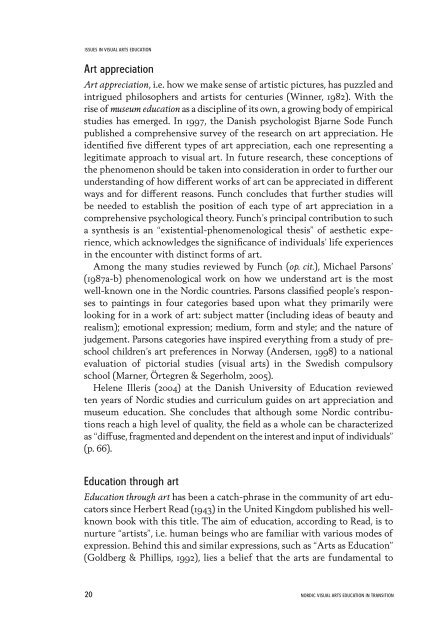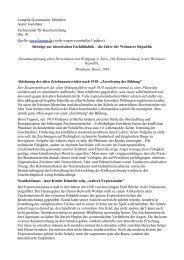Research in Visual Arts Education - The National Society for ...
Research in Visual Arts Education - The National Society for ...
Research in Visual Arts Education - The National Society for ...
Create successful ePaper yourself
Turn your PDF publications into a flip-book with our unique Google optimized e-Paper software.
ISSUES IN VISUAL ARTS EDUCATION<br />
Art appreciation<br />
Art appreciation, i.e. how we make sense of artistic pictures, has puzzled and<br />
<strong>in</strong>trigued philosophers and artists <strong>for</strong> centuries (W<strong>in</strong>ner, 1982). With the<br />
rise of museum education as a discipl<strong>in</strong>e of its own, a grow<strong>in</strong>g body of empirical<br />
studies has emerged. In 1997, the Danish psychologist Bjarne Sode Funch<br />
published a comprehensive survey of the research on art appreciation. He<br />
identified five different types of art appreciation, each one represent<strong>in</strong>g a<br />
legitimate approach to visual art. In future research, these conceptions of<br />
the phenomenon should be taken <strong>in</strong>to consideration <strong>in</strong> order to further our<br />
understand<strong>in</strong>g of how different works of art can be appreciated <strong>in</strong> different<br />
ways and <strong>for</strong> different reasons. Funch concludes that further studies will<br />
be needed to establish the position of each type of art appreciation <strong>in</strong> a<br />
comprehensive psychological theory. Funch’s pr<strong>in</strong>cipal contribution to such<br />
a synthesis is an “existential-phenomenological thesis” of aesthetic experience,<br />
which acknowledges the significance of <strong>in</strong>dividuals’ life experiences<br />
<strong>in</strong> the encounter with dist<strong>in</strong>ct <strong>for</strong>ms of art.<br />
Among the many studies reviewed by Funch (op. cit.), Michael Parsons’<br />
(1987a-b) phenomenological work on how we understand art is the most<br />
well-known one <strong>in</strong> the Nordic countries. Parsons classified people’s responses<br />
to pa<strong>in</strong>t<strong>in</strong>gs <strong>in</strong> four categories based upon what they primarily were<br />
look<strong>in</strong>g <strong>for</strong> <strong>in</strong> a work of art: subject matter (<strong>in</strong>clud<strong>in</strong>g ideas of beauty and<br />
realism); emotional expression; medium, <strong>for</strong>m and style; and the nature of<br />
judgement. Parsons categories have <strong>in</strong>spired everyth<strong>in</strong>g from a study of preschool<br />
children’s art preferences <strong>in</strong> Norway (Andersen, 1998) to a national<br />
evaluation of pictorial studies (visual arts) <strong>in</strong> the Swedish compulsory<br />
school (Marner, Örtegren & Segerholm, 2005).<br />
Helene Illeris (2004) at the Danish University of <strong>Education</strong> reviewed<br />
ten years of Nordic studies and curriculum guides on art appreciation and<br />
museum education. She concludes that although some Nordic contributions<br />
reach a high level of quality, the field as a whole can be characterized<br />
as “diffuse, fragmented and dependent on the <strong>in</strong>terest and <strong>in</strong>put of <strong>in</strong>dividuals”<br />
(p. 66).<br />
<strong>Education</strong> through art<br />
<strong>Education</strong> through art has been a catch-phrase <strong>in</strong> the community of art educators<br />
s<strong>in</strong>ce Herbert Read (1943) <strong>in</strong> the United K<strong>in</strong>gdom published his wellknown<br />
book with this title. <strong>The</strong> aim of education, accord<strong>in</strong>g to Read, is to<br />
nurture “artists”, i.e. human be<strong>in</strong>gs who are familiar with various modes of<br />
expression. Beh<strong>in</strong>d this and similar expressions, such as “<strong>Arts</strong> as <strong>Education</strong>”<br />
(Goldberg & Phillips, 1992), lies a belief that the arts are fundamental to<br />
20 NORDIC VISUAL ARTS EDUCATION IN TRANSITION



